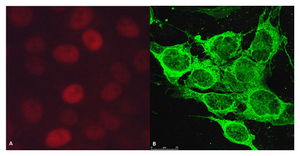Fluorescently labeled Estradiol
| Cat. No. | Amount | Price (EUR) | Buy / Note |
|---|---|---|---|
| PR-958S | 100 μg | 257,00 | Add to Basket/Quote Add to Notepad |
| PR-958L | 5x 100 μg | 734,40 | Add to Basket/Quote Add to Notepad |


For general laboratory use.
Shipping: shipped at 4 °C
Storage Conditions: store at 4 °C
store dark
Shelf Life: 12 months
Molecular Formula: C47H67BrN2O2
Molecular Weight: 771.95 g/mol
Purity: > 97 % (DC, NMR)
Form: lyophilised, glassy to waxy appearance
Color: brownish-red
Solubility: High: MeOH, EtOH, PrOH, DMSO, DMF Moderate: acetone, CH2Cl2, CH3Cl, THF Low: H2O and aqueous buffer systems (after presolution in DMSO >1 μM) Insoluble: Et2O, hydrocarbons such as hexane, heptane, benzene
Spectroscopic Properties: λexc 467 nm, λem 618 nm, ε 29.0 L mmol-1 cm-1 (PBS pH 7.4) λexc 501 nm, λem 596 nm, ε 52.0 L mmol-1 cm-1 (ethanol)
Description:
Estradiol Glow is the ovarian steroid hormone 17-ß-Estradiol labeled with a novel low molecular weight orange/red fluorophor thus retaining its chemical properties and it´s biological activity. This allows for a wide range of applications including
Background
Identification of steroid sensitive cells in target tissues has so far been attempted with either radio labelled hormones and autoradiography or with in situ hybridization and immuno-histochemistry for receptor proteins. Numerous studies have been performed with steroid hormones labelled with either enzymes, fluorophors or immunogenic markers, all resulting in loss of biological properties and hormonal function. Estradiol Glow is 17-ß-estradiol, labelled in a novel way with a low molecular weight biocompatible fluorophor, thus retaining biological activity of the ovarian hormone. Systemic injections into experimental animals revealed accumulation of the fluorescent steroid in nuclei of known estrogen target tissues, including the brain.
Estradiol Glow allows new insights into cellular uptake, intracellular transport and subcellular binding. Mechanisms of rapid steroid actions become transparent on the single cell level.
BIOZ Product Citations:
Selected References:
Jirikowski et al. (2011) Uptake, intracellular transport and physiological effects of biologically active fluorescent steroids. Rapid Responses to Steroid Hormones. 7th International Meeting, 14-17 September 2011, Crete, Greece.